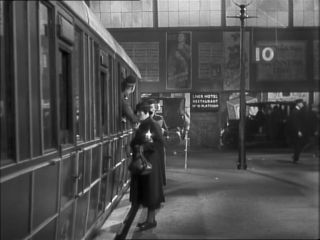The MacGuffin: News and Comment (12/May/2012)
(c) Ken Mogg (2012)
May 12
Hitchcock always liked to get things right. Here, then, are a couple of 39 Steps-related pieces of, well, trivia (or are they?). First, look at the frame-capture below. It represents Hannay's pov from a window of the famous Flying Scotsman at the moment he spots the pursuing spies alighting from their taxi at Platform 10 of King's Cross Station. (But the train is already moving and the spies just fail to board it, giving Hannay a few hours' respite.) All of the detail here is accurate, I think, including the fact that you could enter directly onto the platform without passing through a barrier. How do I know? Well, I just finished reading 'The Man in the Queue' (1929) by Josephine Tey, the author of 'A Shilling for Candles' (1936) which Hitchcock filmed as Young and Innocent. There, someone else is about to flee to Scotland but is worried about being spotted by the police. But his landlady re-assures him: 'There isn't a barrier at King's Cross. I haven't gone up and down to Scotland for nearly thirty years without knowing that. The Scotch platform is open to anyone who wants to walk on.' (Chapter 8) Moreover, that is definitely King's Cross in the frame-capture from Hitchcock's film because I just checked with Danny N in London. But then that raised a puzzle! In John Buchan's 1915 novel, 'The Thirty-Nine Steps', Hannay is described as catching the train not at King's Cross but at St Pancras, which is alongside King's Cross on the Euston Road. Hannay tells us: 'At St Pancras I had no time to take a ticket ... A porter told me the platform, and as I entered it I saw the train already in motion ... but I ... clambered into the last carriage.' (Chapter II) Hmm. Danny thinks that Buchan confused the two stations although, just possibly, there had been a change of station caused by the war. (As far as Danny knows, the Flying Scotsman has always departed from King's Cross.) Now another item. Not only did Hitchcock like to get things right but he liked not to waste anything! In Buchan's novel the tune that Hannay whistles at one point is 'Annie Laurie', which identifies him to intelligence boss Sir Walter Bullivant. But of course Hitchcock's film changed things so that the tune that Hannay can't get out of his head is the catchy one he had heard at the music hall in the opening scene - it sounds suitably like the 'Cuckoo' tune of Laurel & Hardy (as I noted in 'The Alfred Hitchcock Story'). It's use by the film is realistic and helps fill otherwise 'empty' moments. However, Hitchcock did use 'Annie Laurie' in a later film and that was The Paradine Case. We hear a whistled snatch of it echoing down a cell corridor after Mrs Paradine is first incarcerated, and its use is suitably mournful. (Note. There are versions of 'Annie Laurie' on YouTube.) The words of the song are about a failed love affair, based on a poem by William Douglas (1672?-1748), and the song's well-known refrain is this: 'And for bonnie Annie Laurie/ I'd lay me doon and dee.' Which is appropriate both to the prison and possibly the person whistling it, and certainly to Mrs Paradine herself who seems to have staked all on an unrequited passion for André Latour and who will eventually be found guilty of her husband's murder. Interestingly, Hitchcock at this time was toying with the idea of filming Heinrich Heine's mournful verse drama 'Ratcliff' (1822), set in the Scottish Highlands and again being about a love affair that fails, ending in tragedy. (Btw, it might have been Hitchcock's first 'ghost' film, something he also contemplated in his cherished project of filming Scottish playwright J.M. Barrie's 1920 play, 'Mary Rose'.) Finally, to end on a lighter note, here's something that Danny N told me this week apropos the adjacent King's Cross and St Pancras railway stations. The robbery scene in one of Danny's favourite films, Alexander Mackendrick's The Ladykillers (1955), 'takes place in the narrow streets between King's Cross and St Pancras'.
This material is copyright of Ken Mogg and the Hitchcock Scholars/'MacGuffin' website (home page) and is archived with the permission of the copyright holder. |

